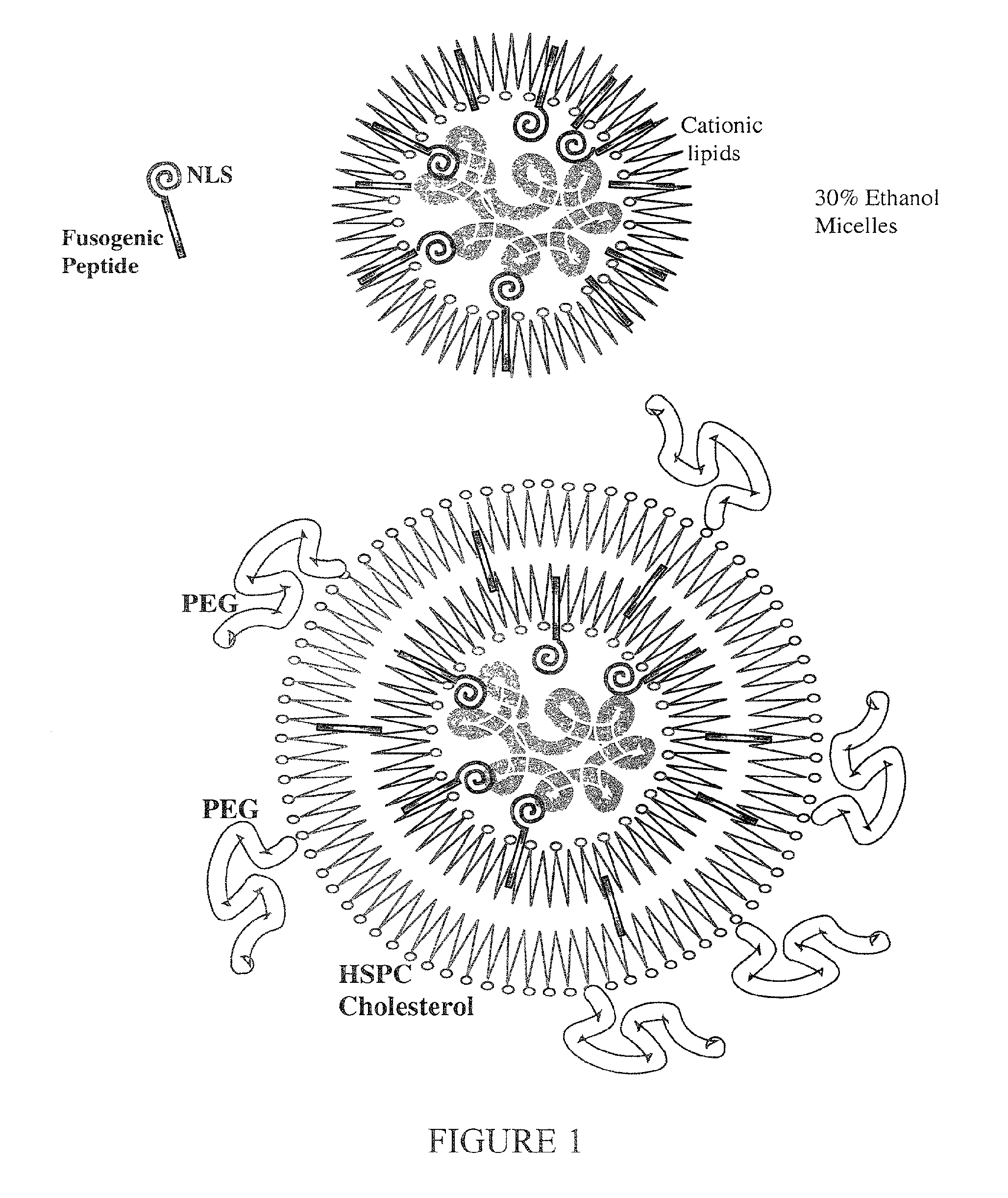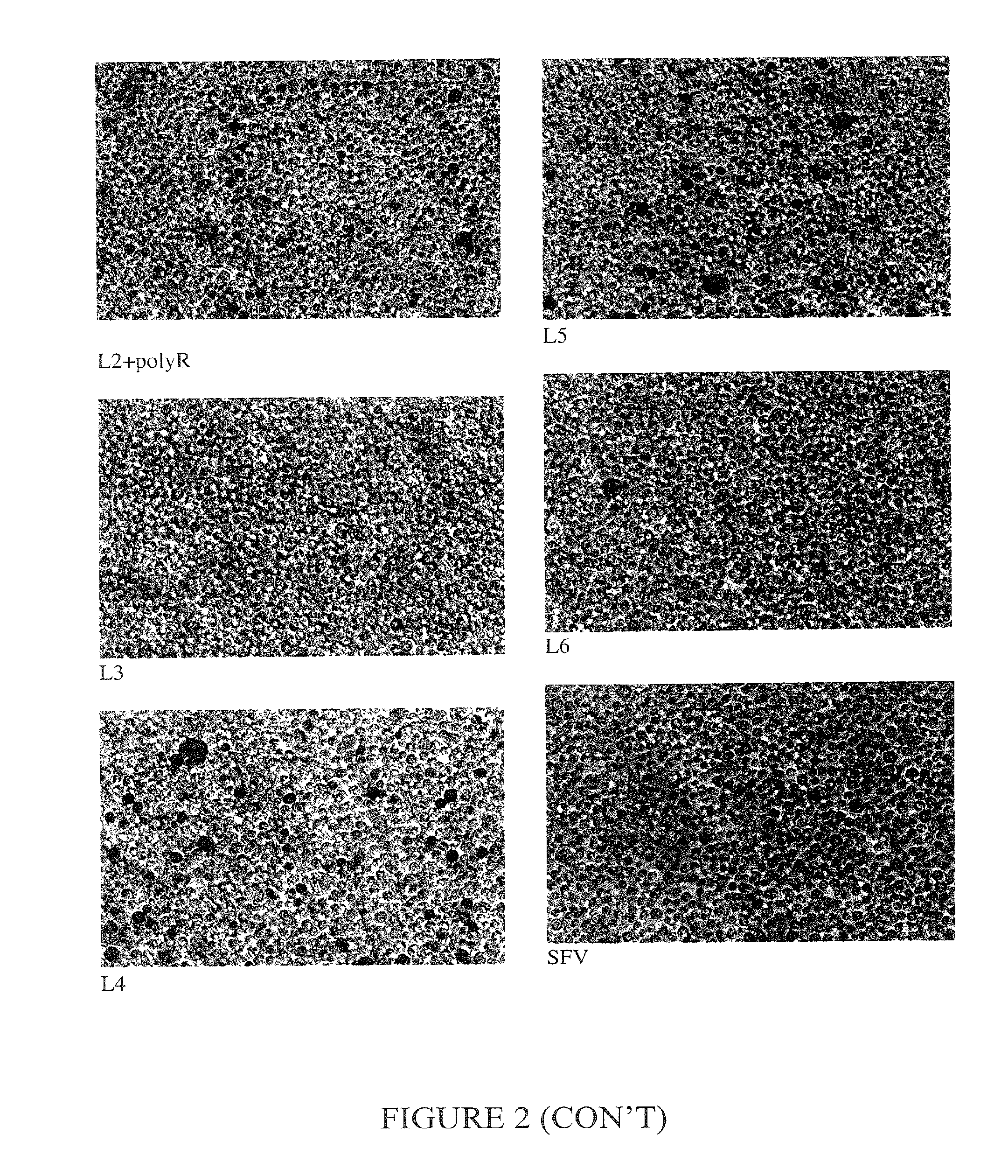Encapsulation of Plasmid DNA (Lipogenes™) and Therapeutic Agents with Nuclear Localization Signal/Fusogenic Peptide Conjugates into Targeted Liposome Complexes
a technology of plasmid dna and lipogenes, which is applied in the direction of drug compositions, genetic material ingredients, pharmaceutical delivery mechanisms, etc., can solve the problems of difficulty in efficiently delivering polynucleotide to the tumor site, and the routine use of gene therapy for human disease treatment has not yet been perfected, so as to improve the entry and treatment effect, the effect of high yield
- Summary
- Abstract
- Description
- Claims
- Application Information
AI Technical Summary
Problems solved by technology
Method used
Image
Examples
example 1
[0169]Plasmid DNA condenses with various agents, as well as various formulations of cationic liposomes. The condensation affects the level of expression of the reporter beta-galactosidase gene after transfection of K562 human erythroleukemia cell cultures. Liposome compositions are shown in the Table below and in FIG. 2. All lipids were from Avanti Polar Lipids (700 Industrial Park Drive, Alabaster, Ala. 35007). The optimal ratio of lipid to DNA was 7 nmoles total lipid / μg DNA. The transfection reagent (10 μg DNA mixed with 70 nmoles total lipid) was transferred to a small culture flask followed by the addition of 10 ml K562 cell culture (about 2 million cells total); mixing of cells with the transfection reagent was at 5-10 min after mixing DNA with liposomes. Cells were assayed for beta-galactosidase activity several times at 1-30 days post-transfection. The transfected cells were maintained in cell culture as normal cell cultures.
[0170]Best results were obtained when the cells us...
example 2
Targeting Genes to Tumors Using Gene Vehicles (Lipogenes)
[0172]As shown in FIG. 3, tumor targeting in SCID (severe combined immunodeficient) mice were implanted subcutaneously, at two sites, with human MCF-7 breast cancer cells. The cells were allowed to develop into large, measurable solid tumors at about 30 days post-inoculation. Mice were injected intraperitoneously with 0.2 mg plasmid pCMVβ DNA (size of the plasmid is ˜4 kb) per animal carrying the bacterial beta-galactosidase reporter gene. Plasmid DNA (200 μg, 2.0 mg / ml, 0.1 ml) was incubated for 5 min with 200 μl neutral liposomes of the composition 40% cholesterol, 20% dioleoylphosphatidylethanolamine(DOPE), 12% palmitoyloleoylphosphatidylcholine (POPC), 10% hydrogenated soy phosphatidylcholine (HSPC), 10% distearoylphosphatidylethanolamine (DSPE), 5% sphingomyelin (SM), and 3% derivatized vesicle-forming lipid M-PEG-DSPE.
[0173]At this stage, weak complexation of plasmid DNA with neutral (zwitterionic) liposomes takes place....
PUM
| Property | Measurement | Unit |
|---|---|---|
| mole percent | aaaaa | aaaaa |
| lipid composition | aaaaa | aaaaa |
| hydrophobic | aaaaa | aaaaa |
Abstract
Description
Claims
Application Information
 Login to View More
Login to View More - R&D
- Intellectual Property
- Life Sciences
- Materials
- Tech Scout
- Unparalleled Data Quality
- Higher Quality Content
- 60% Fewer Hallucinations
Browse by: Latest US Patents, China's latest patents, Technical Efficacy Thesaurus, Application Domain, Technology Topic, Popular Technical Reports.
© 2025 PatSnap. All rights reserved.Legal|Privacy policy|Modern Slavery Act Transparency Statement|Sitemap|About US| Contact US: help@patsnap.com



